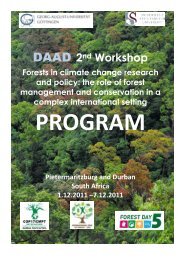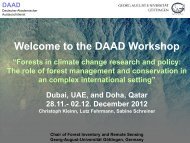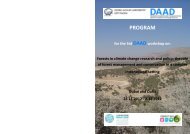Proceedings of the Workshop - Georg-August-Universität Göttingen
Proceedings of the Workshop - Georg-August-Universität Göttingen
Proceedings of the Workshop - Georg-August-Universität Göttingen
Create successful ePaper yourself
Turn your PDF publications into a flip-book with our unique Google optimized e-Paper software.
CLIMATE CHANGE MITIGATION AND ADAPTATION STRATEGIES<br />
IMPLEMENTED IN BUFFER ZONES IN COSTA RICA: CASE STUDY LA<br />
AMISTAD BIOSPHERE RESERVE<br />
Cinthia Granda 1 , Max Villalobos 1 , David Morales-Hidalgo 2<br />
1 Master Students <strong>of</strong> <strong>the</strong> Natural Resources Management Program. UNED. Costa Rica.<br />
AMISCONDE Project Staff 2004-2007. Email: granda31@gmail.com &<br />
mvillalobos@cct.or.cr.<br />
2 Director Mesoamerican Develop Center <strong>of</strong> Dry Tropics, National University <strong>of</strong> Costa<br />
Rica. CEMEDE-UNA. Email: dmorale@una.ac.cr. Pr<strong>of</strong>essor <strong>of</strong> <strong>the</strong> Natural Resources<br />
Management Master Program, UNED, Costa Rica<br />
Abstract<br />
Searching for solutions to cope with <strong>the</strong> effects <strong>of</strong> global climate change<br />
has become one <strong>of</strong> <strong>the</strong> most pressing challenges facing humankind. IPCC,<br />
states that <strong>the</strong> emission <strong>of</strong> greenhouse gases (GHG) is <strong>the</strong> principal driver<br />
<strong>of</strong> this phenomenon. In Costa Rica, <strong>the</strong> generation <strong>of</strong> energy, agriculture<br />
and waste management have been identified as <strong>the</strong> main sectors<br />
contributing to national GHG emissions. In this context, ecosystem<br />
management plays a central role in climate change adaptation and<br />
mitigation, because ecosystems provide important regulating services such<br />
as resilience against climatic extreme events and carbon sequestration.<br />
Due to <strong>the</strong> tight relationships between biodiversity conservation and climate<br />
change impacts, in Costa Rica, <strong>the</strong> consolidation <strong>of</strong> <strong>the</strong> country’s protected<br />
areas and <strong>the</strong>ir respective buffer zones has been proposed as a central<br />
adaptation strategy.<br />
This paper aims to present a variety <strong>of</strong> climate change adaptation and<br />
mitigation strategies in buffer zones <strong>of</strong> <strong>the</strong> La Amistad Biosphere Reserve,<br />
which have effectively been implemented by <strong>the</strong> AMISCONDE project<br />
between 2004- 2007. Strategies such as: improving <strong>the</strong> biological<br />
connectivity, a Conservation C<strong>of</strong>fee Program implementation, flagship<br />
species definition and Payments for Environmental Services (PES) will be<br />
presented and <strong>the</strong> lesson learned during <strong>the</strong> project period will be<br />
discussed. This information can serve as a basis for future initiatives in<br />
protected area buffer zones in tropical areas within <strong>the</strong> context <strong>of</strong><br />
biodiversity conservation and climate change adaptation and mitigation<br />
policies.<br />
Keywords: Climate Change, Adaptation, Mitigation, Buffer Zones,<br />
AMISCONDE, Costa Rica.<br />
1. Introduction<br />
The search for solutions to cope with <strong>the</strong> effects <strong>of</strong> global climate change has become<br />
one <strong>of</strong> <strong>the</strong> most pressing challenges faceing humankind (Créach et al. 2008). Climate<br />
change refers to effects which are caused directly or indirectly by human activities that<br />
contribute to changing <strong>the</strong> composition <strong>of</strong> <strong>the</strong> global atmosphere (UNFCCC 1997). The<br />
Fourth Assessment Report <strong>of</strong> <strong>the</strong> Intergovernmental Panel on Climate Change (IPCC),<br />
states that <strong>the</strong> emission <strong>of</strong> greenhouse gases (GHG) is <strong>the</strong> principal driver for recently<br />
observed phenomena such as an overall warming <strong>of</strong> <strong>the</strong> climate system, drastic<br />
changes in precipitation regimes, more frequent and severe droughts and floods in<br />
tropical and subtropical regions, an increased activity <strong>of</strong> tropical storms in <strong>the</strong> Atlantic<br />
as well as shifts in plant and animal ranges, among o<strong>the</strong>rs (Solomon et al. 2007).<br />
‐ 32 -










